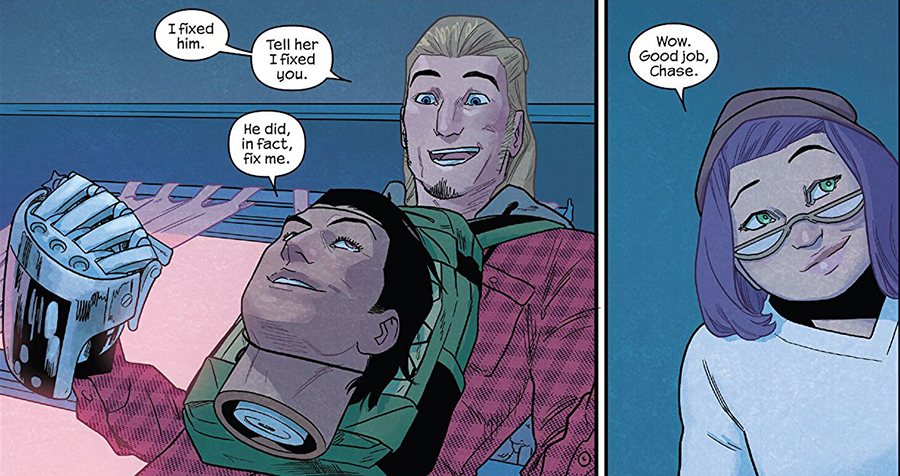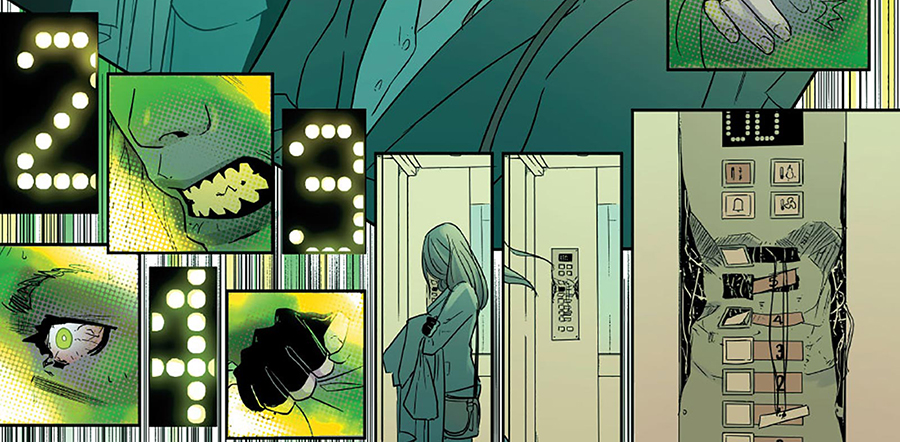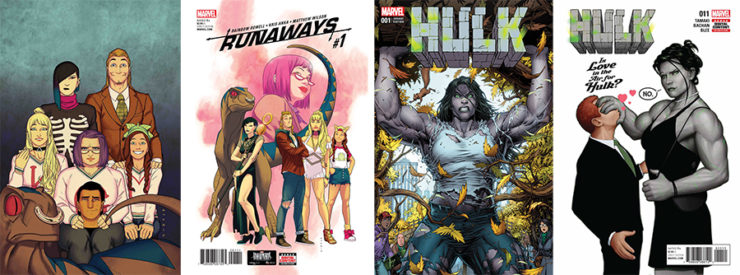I enjoy a good superhero comic as much as the next geek. But after awhile it can feel like I’m reading story over and over again with a rotating cast of characters. Sometimes I need to break up the monotony with something a little different. Superhero stories are great for telling fun, light, action/adventure tales of derring-do and big battles. But they can also tell deeper stories about trauma, mental illness, acceptance, making your own family, and what it means to be (super) human.
This month, we’re reading two comics dealing with recovering from the grief of losing people you love. Runaways is fairly new and Hulk on its last legs, but both are introspective yet revelatory.
Runaways

When we last left the Runaways, several team members were dead and the group had scattered to the wind. Until one day when Chase appears in Nico’s rundown apartment with Gertrude’s body. Turns out Chase went back in time to try and save her, but messed up the timing and found her seconds too late. Eventually they resuscitate her then set off to reunite the band. Except no one really wants to get back together. Nico is mired in gloom and loneliness, Karolina has walled off the darker parts of her life in a desperate attempt at happiness, Chase is lost to guilt and a mild obsession with reactivating another seemingly dead ex-Runaway Victor, and Molly is happily ensconced in her mad scientist grandmother’s care.
At first Gert is the team cheerleader, but she soon realizes how great the divide really is. They’re not just older than her, but have all gone through years of heartache, loss, and betrayal she missed out on. Too much has happened to pick up where Gert left off. Nico silently suffers her own sense of alienation. From both Gert and Nico’s perspective, the rest of their teammates have moved on with their lives, but as writer Rainbow Rowell reveals, none are as settled as they let on. But this isn’t a sad series by any means. Rowell lets the characters be their true goofy, playful selves, even when confronted with all the things they lost. Her writing is as sharp and charming as always, and the arc she’s crafted is brimming with hope.
The creative team behind Runaways work in perfect synchronicity. Individually they’re great, but their collaborative output is even better. Kris Anka’s style is ideal for Rowell’s YA sensibilities. Anka has a real eye for facial expressions, subtle, melodramatic, and everything in between. His backgrounds are full of eye-catching details and side jokes. There’s a reason he’s one of my favorite working comics artists. Matt Wilson’s colors are strong throughout—I love his little details like Karolina’s mismatched ankle socks, palette shifts to match Molly’s mood, and Nico’s fading ombre—but his standout scene is when Karolina goes all rainbow bright. It’s absolutely stunning. Joe Caramanga nails the lettering from page one. From changing the font size to match vocal tone to bolding speech bubbles to pitch-perfect rendering of Rowell’s angsty, young adult sarcasm, it just works so well. Fans of the original Runaways series and newbies alike will find a lot to adore in this relaunch.
Writer: Rainbow Rowell; art: Kris Anka; color art: Matthew Wilson; letterer: Joe Caramagna. Marvel published the most recent issue (#6) on February 7, 2018.
Hulk/She-Hulk

Jennifer is slowly piecing her life back together as she comes to terms with the catastrophic events of Civil War II—her near-death experience and subsequent coma, the sudden death of her cousin Bruce Banner (uh…spoilers?), and the stress of friends battling friends. She just wants to live a quiet, reality-TV-baking-show-filled life as a lawyer. A new client dealing with her own violence-induced trauma forces Jennifer out of her self-imposed isolation. This time she’s the not jolly green Shulkie we all know and love, but a gray-skinned rage monster. If she can’t confront her personal demons, the fear, self-loathing, and deep-seated anger may conquer her completely.
As to the dual titles, Jennifer took the moniker “Hulk” after Civil War II, but with the Marvel Legacy relaunch she reverted back to “She-Hulk.” Also, the numbering system jumped to #159 by combining all the issues together from all her various solo series. The Hulk series transferred to Amadeus Cho and Jennifer’s went back to She-Hulk. Long story short, don’t let the unnecessarily complicating numbering or titling scare you off.
Throughout the series, Tamaki has Jennifer constantly break the fourth wall. YMMV on that technique—either you think it’s a fun device or a cheesy gimmick—but I enjoyed it, particularly in issue #11 when she goes on a spectacularly terrible first date. Nico Leon’s art is expressive and nuanced. Crowded, busy scenes never feel overwhelming or cluttered and the style is so engaging. Georges Duarte’s art in the second arc is perfect for the frenetic physicality of gray Hulk. Matt Milla’s colors pair especially well with both artists. You can almost feel Jennifer’s energy coming off the page. With eerie glowing lights and pitch-black shadows contrasting the earthy, toned-down color palette, Milla highlights the division between Hulk and Jennifer. Cory Petit and Travis Lanham really get Tamaki’s unique cadence. They manage to both keep the speech bubbles and text boxes flowing around the art while preserving the back-and-forth conversational feel between the narration and characters.
Sadly, the March 2018 issue will be the last; the series was axed in the Marvel diversity slaughterhouse a few months back. And it’s a damn shame. While Hulk/She-Hulk hasn’t always been well-paced, it’s consistently compelling. This isn’t your typical caped crusader comic. Tamaki focuses on what happens after one of those multiverse-shattering event crossovers. It’s a story about living with mental illness, survivor’s remorse, and overcoming (or at least learning to deal with) trauma. Jennifer spends more time resisting her Hulkiness out than she does actually Hulking out, which might not work for readers wanting an action-packed superhero story. There are plenty of fight scenes, especially in the final arc, but Tamaki builds up slowly (sometimes too slowly) to those moments. But that’s what made me love it all the more.
Writer: Mariko Tamaki; art: Nico Leon, Dalibor Talajic, Georges Duarte, Julian Lopez, Francesco Gaston, Bachan, Jahnoy Lindsay; colors: Matt Milla, Andrew Crossley, Federico Blee, Chris Sotomayor; letters: Cory Petit, Travis Lanham. Marvel published the most recent issue (#162) on February 7, 2018, and the final issue will be #163.
Alex Brown is a YA librarian by day, local historian by night, pop culture critic/reviewer by passion, and QWoC all the time. Keep up with her every move on Twitter, check out her endless barrage of cute rat pics on Instagram, or get lost in the rabbit warren of ships and fandoms on Tumblr.










